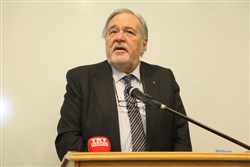 On December 7, the Department of History hosted a seminar on historic cultural interaction in Anatolia, titled “Cross-Cultural Encounters in Anatolia Between the Byzantines, Persians and
On December 7, the Department of History hosted a seminar on historic cultural interaction in Anatolia, titled “Cross-Cultural Encounters in Anatolia Between the Byzantines, Persians and
Ottomans.” Held in the UNAM Conference Hall, the event featured a panel of Turkish, Iranian and Italian scholars, who discussed cross-cultural interaction in Anatolia from the Roman and Byzantine periods to the Ottoman era.
Opening remarks were given by the deputy ambassador of Italy, Ludovico Serra, and the cultural attaché of the Embassy of the Islamic Republic of Iran, Hasan Safarkhani, both of whom referred to Anatolia’s role as a crossroads of civilizations and emphasized the importance of unity and friendship.
Next on the program was a keynote speech by Prof. İlber Ortaylı. In his talk, Prof. Ortaylı stated that Anatolia was greatly influenced by Persian culture, traces of which may be observed in many museums and archaeological sites throughout Anatolia as well as the vocabulary used in Ottoman records. While it is possible to see similar philological influences between the Italian and Ottoman languages, the Italian peninsula was also in many ways a center of both the oriental and the occidental cultures, especially through commerce. Prof. Ortaylı finished his remarks by noting the importance of studying the Persian and Italian cultures and archives.
 After this introduction, the event continued with the presentations of the panelists. In his talk, “Caravans of Love on the Roads of Anatolia, From Tabriz to Venice,” Dr. Mehmet Kalpaklı (Bilkent University) stated that Anatolia was a crossroads not only of commerce, but also, and perhaps even more significantly, of philosophy, literature and culture, citing examples from poets such as Necati. Dr. Ali Kalirad (University of Tehran) spoke on the topic “The Heir of Xerxes or Alexander’s Successor? The Portraits of Mehmed the Conqueror in Two Persian and Greek Chronicles,” discussing Mehmed II’s portrayal in the works of İdris-i Bidlisi and Michael Critobulus, and pointing to the common legacy of the cultures. The final presentation of the panel was given by Dr. Luca Zavagno (Bilkent University). In his talk, “City Encounters in Byzantine Anatolia Between Late Antiquity and the Early Middle Ages,” Dr. Zavagno used many visual examples to show how Roman and Ottoman architecture influenced cities in Byzantine Anatolia.
After this introduction, the event continued with the presentations of the panelists. In his talk, “Caravans of Love on the Roads of Anatolia, From Tabriz to Venice,” Dr. Mehmet Kalpaklı (Bilkent University) stated that Anatolia was a crossroads not only of commerce, but also, and perhaps even more significantly, of philosophy, literature and culture, citing examples from poets such as Necati. Dr. Ali Kalirad (University of Tehran) spoke on the topic “The Heir of Xerxes or Alexander’s Successor? The Portraits of Mehmed the Conqueror in Two Persian and Greek Chronicles,” discussing Mehmed II’s portrayal in the works of İdris-i Bidlisi and Michael Critobulus, and pointing to the common legacy of the cultures. The final presentation of the panel was given by Dr. Luca Zavagno (Bilkent University). In his talk, “City Encounters in Byzantine Anatolia Between Late Antiquity and the Early Middle Ages,” Dr. Zavagno used many visual examples to show how Roman and Ottoman architecture influenced cities in Byzantine Anatolia.
The event attracted attendees from both Bilkent and outside, providing the audience an excellent opportunity to recognize, remember and appreciate the significance of Anatolia as a meeting point of civilizations.
By Burcu Feyzullahoğlu, PhD Student, Department of History
